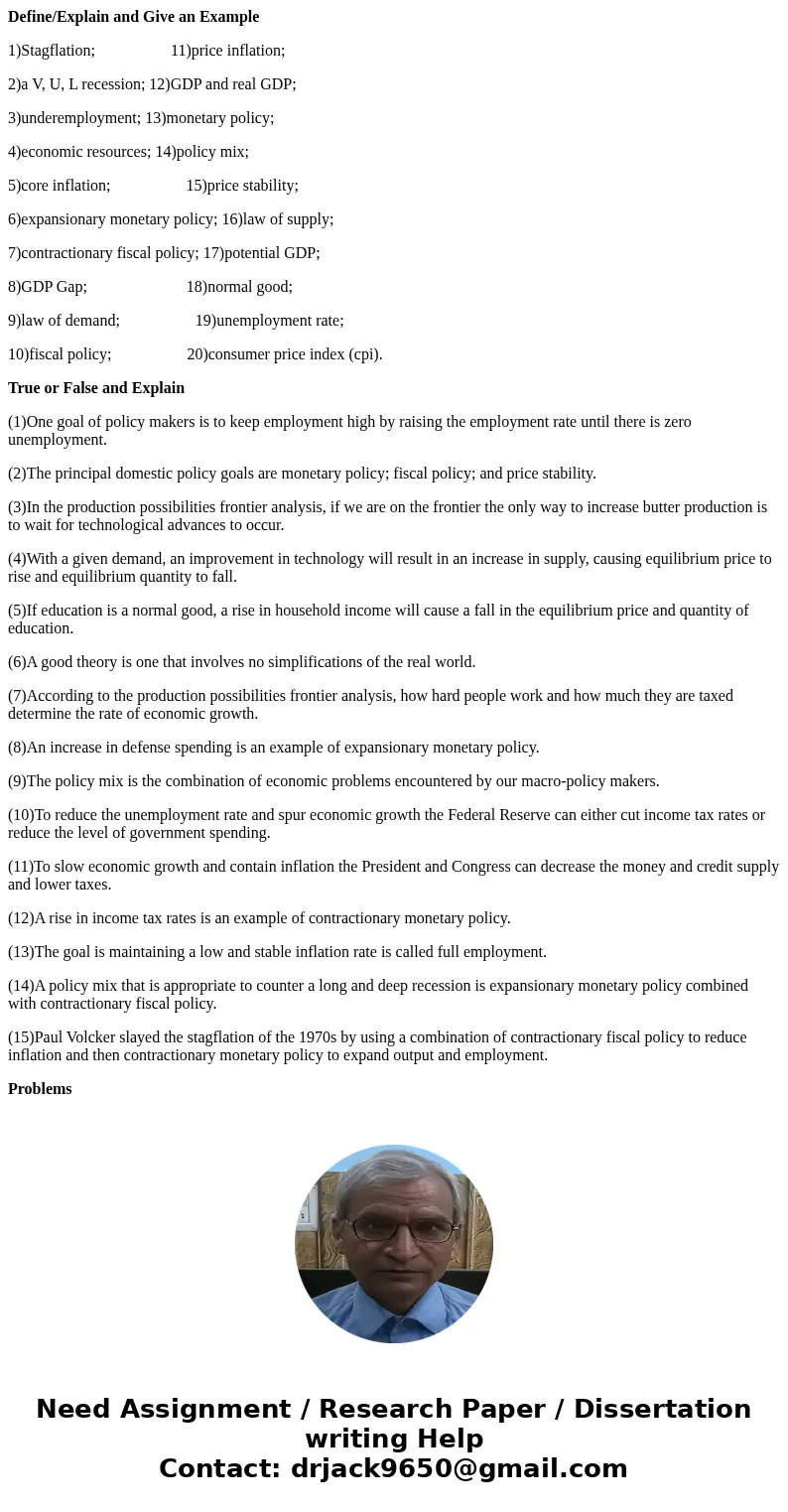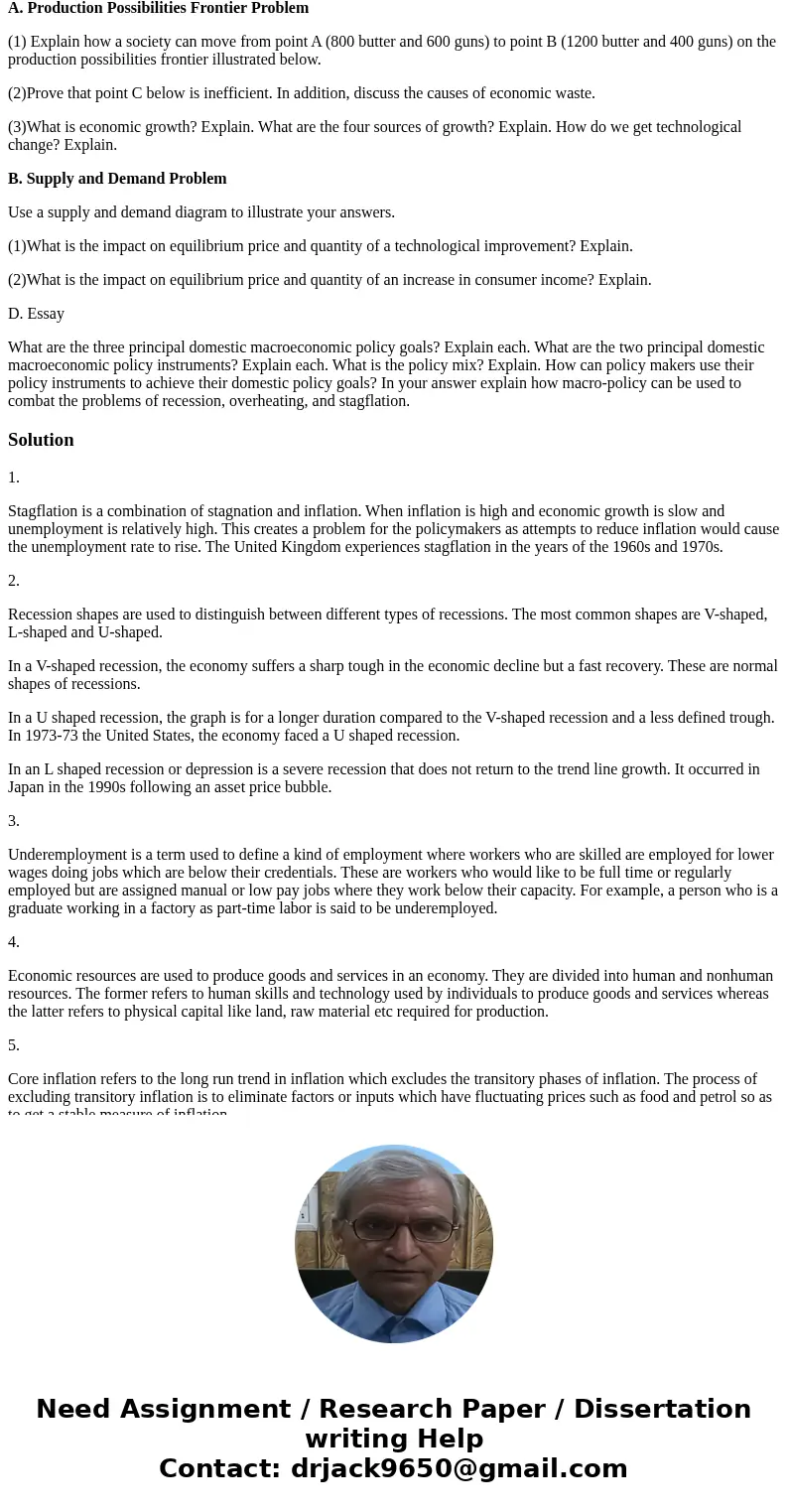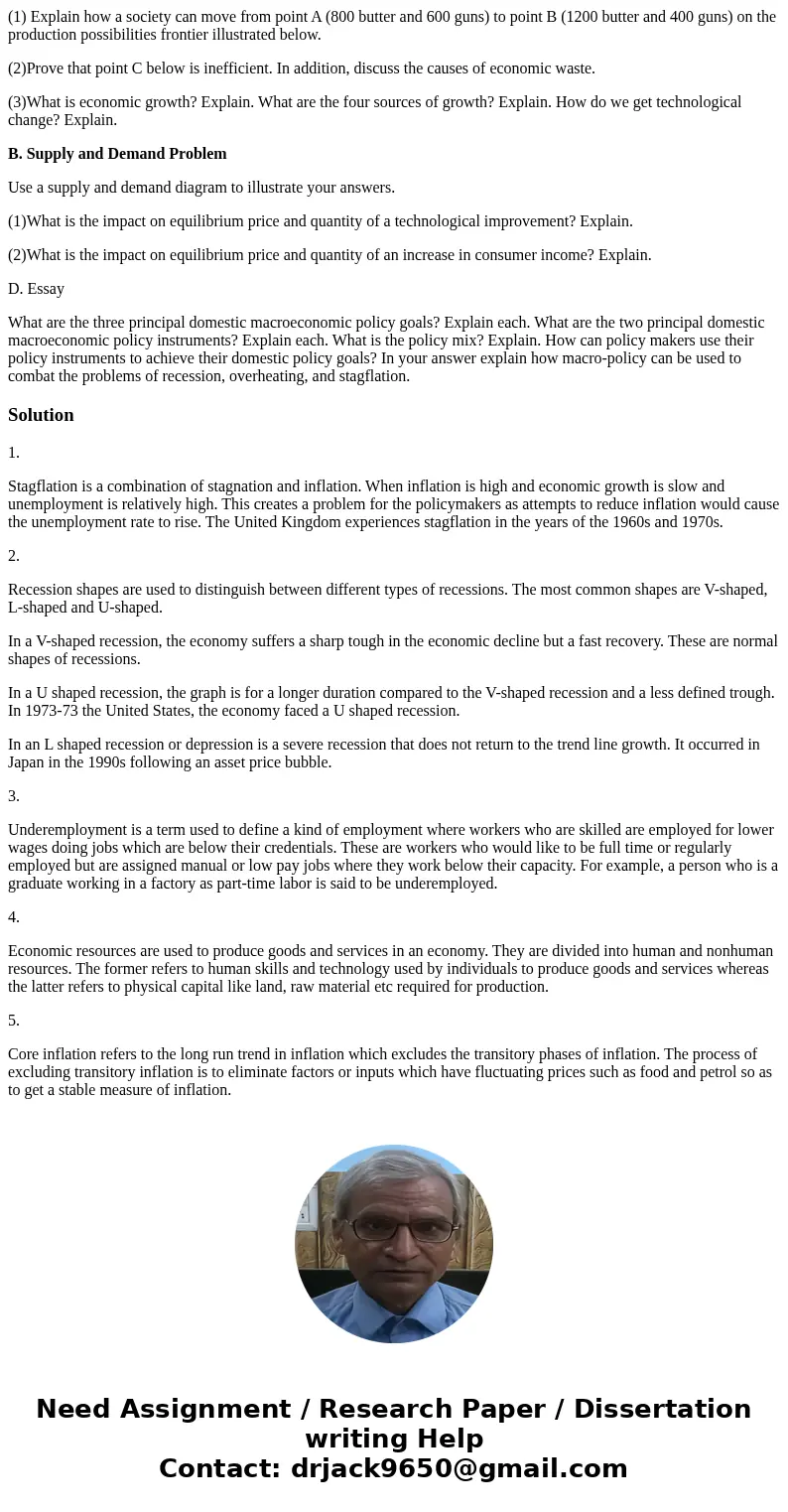DefineExplain and Give an Example 1Stagflation 11price infla
Define/Explain and Give an Example
1)Stagflation; 11)price inflation;
2)a V, U, L recession; 12)GDP and real GDP;
3)underemployment; 13)monetary policy;
4)economic resources; 14)policy mix;
5)core inflation; 15)price stability;
6)expansionary monetary policy; 16)law of supply;
7)contractionary fiscal policy; 17)potential GDP;
8)GDP Gap; 18)normal good;
9)law of demand; 19)unemployment rate;
10)fiscal policy; 20)consumer price index (cpi).
True or False and Explain
(1)One goal of policy makers is to keep employment high by raising the employment rate until there is zero unemployment.
(2)The principal domestic policy goals are monetary policy; fiscal policy; and price stability.
(3)In the production possibilities frontier analysis, if we are on the frontier the only way to increase butter production is to wait for technological advances to occur.
(4)With a given demand, an improvement in technology will result in an increase in supply, causing equilibrium price to rise and equilibrium quantity to fall.
(5)If education is a normal good, a rise in household income will cause a fall in the equilibrium price and quantity of education.
(6)A good theory is one that involves no simplifications of the real world.
(7)According to the production possibilities frontier analysis, how hard people work and how much they are taxed determine the rate of economic growth.
(8)An increase in defense spending is an example of expansionary monetary policy.
(9)The policy mix is the combination of economic problems encountered by our macro-policy makers.
(10)To reduce the unemployment rate and spur economic growth the Federal Reserve can either cut income tax rates or reduce the level of government spending.
(11)To slow economic growth and contain inflation the President and Congress can decrease the money and credit supply and lower taxes.
(12)A rise in income tax rates is an example of contractionary monetary policy.
(13)The goal is maintaining a low and stable inflation rate is called full employment.
(14)A policy mix that is appropriate to counter a long and deep recession is expansionary monetary policy combined with contractionary fiscal policy.
(15)Paul Volcker slayed the stagflation of the 1970s by using a combination of contractionary fiscal policy to reduce inflation and then contractionary monetary policy to expand output and employment.
Problems
A. Production Possibilities Frontier Problem
(1) Explain how a society can move from point A (800 butter and 600 guns) to point B (1200 butter and 400 guns) on the production possibilities frontier illustrated below.
(2)Prove that point C below is inefficient. In addition, discuss the causes of economic waste.
(3)What is economic growth? Explain. What are the four sources of growth? Explain. How do we get technological change? Explain.
B. Supply and Demand Problem
Use a supply and demand diagram to illustrate your answers.
(1)What is the impact on equilibrium price and quantity of a technological improvement? Explain.
(2)What is the impact on equilibrium price and quantity of an increase in consumer income? Explain.
D. Essay
What are the three principal domestic macroeconomic policy goals? Explain each. What are the two principal domestic macroeconomic policy instruments? Explain each. What is the policy mix? Explain. How can policy makers use their policy instruments to achieve their domestic policy goals? In your answer explain how macro-policy can be used to combat the problems of recession, overheating, and stagflation.
Solution
1.
Stagflation is a combination of stagnation and inflation. When inflation is high and economic growth is slow and unemployment is relatively high. This creates a problem for the policymakers as attempts to reduce inflation would cause the unemployment rate to rise. The United Kingdom experiences stagflation in the years of the 1960s and 1970s.
2.
Recession shapes are used to distinguish between different types of recessions. The most common shapes are V-shaped, L-shaped and U-shaped.
In a V-shaped recession, the economy suffers a sharp tough in the economic decline but a fast recovery. These are normal shapes of recessions.
In a U shaped recession, the graph is for a longer duration compared to the V-shaped recession and a less defined trough. In 1973-73 the United States, the economy faced a U shaped recession.
In an L shaped recession or depression is a severe recession that does not return to the trend line growth. It occurred in Japan in the 1990s following an asset price bubble.
3.
Underemployment is a term used to define a kind of employment where workers who are skilled are employed for lower wages doing jobs which are below their credentials. These are workers who would like to be full time or regularly employed but are assigned manual or low pay jobs where they work below their capacity. For example, a person who is a graduate working in a factory as part-time labor is said to be underemployed.
4.
Economic resources are used to produce goods and services in an economy. They are divided into human and nonhuman resources. The former refers to human skills and technology used by individuals to produce goods and services whereas the latter refers to physical capital like land, raw material etc required for production.
5.
Core inflation refers to the long run trend in inflation which excludes the transitory phases of inflation. The process of excluding transitory inflation is to eliminate factors or inputs which have fluctuating prices such as food and petrol so as to get a stable measure of inflation.



 Homework Sourse
Homework Sourse